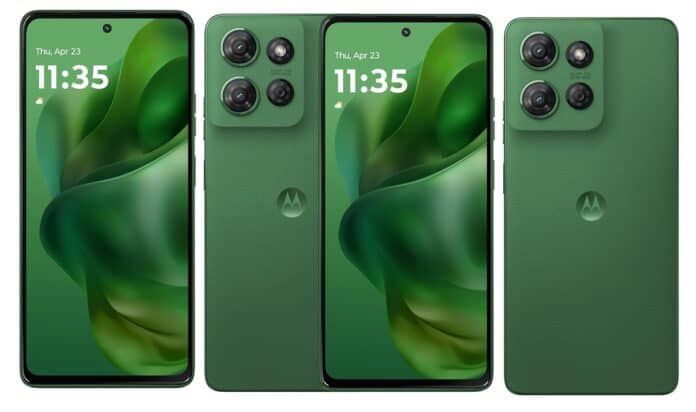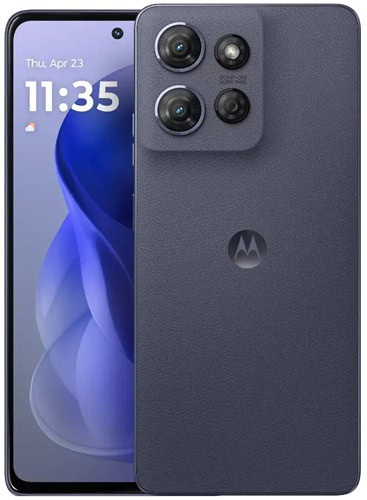Motorola Moto G Power (2025) is the newest budget phone from Motorola’s Moto G-series, rivaling the likes of Samsung Galaxy A16 in the same price tier. It comes with a long-lasting battery, a better camera setup, and an eye-friendly 120Hz LCD display. The Moto G Power (2025) is equipped with the Mediatek Dimensity 6300 SoC with 128GB storage and 8GB RAM. With a 5000mAh battery and running Android 15, the Moto G Power (2025) combines performance, reliability, and value for an affordable price.
Motorola Moto G Power (2025) Key Specs and Features
- 6.8 inches IPS LCD Display, 1080 x 2388 pixels (~385 ppi density), 120Hz Refresh Rate
- Android 15, up to 2 major Android upgrades
- Mediatek Dimensity 6300 (6 nm) Octa Core Processor
- 8GB RAM
- 50 MP (wide) + 8 MP (ultrawide) Dual Rear Camera
- 16 MP Front Camera
- Fingerprint Sensor (side mounted)
- Dust and Water Resistance (IP68/IP69)
- MIL-STD 810H Tested
- 128GB Built-in Storage
- 4G LTE Support
- 5G Support
- eSIM Support
- 30W Fast Charging Capacity
- 5000 mAh Battery
Design
The Motorola Moto G Power (2025) continues Motorola’s tradition of offering practical, no-nonsense designs with a few subtle upgrades that give it a more premium feel. While it doesn’t break new ground in terms of innovation, it’s a well-built device that balances aesthetics and functionality.
The Android phone has grown slightly in size compared to its predecessor, now featuring a 6.8-inch display (up from 6.7 inches). This makes it a bit larger overall, measuring 6.58 x 3.0 x 0.32 inches (HWD) and weighing 6.81 ounces.
While it’s slightly bulkier than the previous model (6.47 x 2.95 x 0.32 inches, 6.84 ounces), the difference is minimal and doesn’t significantly impact its ergonomics. The thin bezels and rounded corners give it a modern look, and the solid metal frame adds a touch of durability and premium appeal.
At the top of the display, there’s a small, round cutout for the selfie camera, which is discreet and doesn’t distract from the overall screen experience.
The side frame, however, is made of plastic but is nicely painted with a matte finish, blending seamlessly with the overall design.
The back of the device is made of eco-leather, which is essentially a silicone polymer designed to mimic the feel of leather. It has a slightly rubberized texture that feels pleasant to the touch and provides a good grip, reducing the chances of accidental slips.
On the top left corner sits the square camera bump wrapped in faux leather, creating a cohesive look from top to bottom. The camera module houses three lenses, though one of them is actually just an ambient light sensor, which might be a bit misleading at first glance. The rear panel is available in Forest Gray or Sapphire Blue, though it leans more toward a plastic-like feel in practice.
The phone’s left side features a slot for SIM cards and microSD cards, while the right side houses the power button, which doubles as a fingerprint sensor, and the volume buttons. The buttons are tactile and produce an audible clicking sound when pressed, giving a satisfying feedback. On the bottom, you’ll find the USB-C port for charging, flanked by a 3.5mm headphone jack on the left and a speaker grille on the right.
In terms of durability, the Motorola Moto G Power (2025) comes with Corning Gorilla Glass 3 for screen protection, which should help guard against minor scratches and drops. Motorola also claims the phone is “water repellent,” meaning it can withstand splashes or light sprays, though it’s not fully waterproof.
Display
The Motorola Moto G Power (2025) features a 6.7-inch IPS LCD display with a resolution of 1,080 x 2,388 pixels. This gives it a relatively sharp display with a pixel density of about 262 pixels per inch.
It also has a 120Hz refresh rate, which ensures smoother scrolling and gaming experiences compared to standard 60Hz displays. However, it’s worth mentioning that while the 120Hz refresh rate is a nice addition, the IPS LCD technology still doesn’t quite match the color vibrancy and contrast levels of an OLED panel.
For example, the Galaxy A16 5G, which falls in the same price range, uses an OLED display that generally looks more vibrant and rich, particularly with deeper blacks. However, thanks to the 120Hz refresh rate, which enhances the overall fluidity of interactions, the display is ideal for streaming videos and playing games
Additionally, the refresh rate is customizable, it offers three modes: 60Hz, 120Hz, and Auto. The Auto mode dynamically adjusts the refresh rate based on the phone’s activity.
For instance, it will ramp up to 120Hz when you’re actively using the phone, but will drop to 60Hz (and sometimes 90Hz) when the screen is idle to conserve battery life. However, it’s worth noting that the phone tends to limit the refresh rate to 60Hz in system menus and certain apps, like Chrome, which means the 120Hz experience isn’t always available throughout the system.
Additionally, the display has a screen-to-body ratio of 84.9% screen-to-body ratio coupled with a 20:9 aspect ratio, enhancing the overall visual experience of the device. Overall, the Motorola Moto G Power (2025) offers productive results with vibrant and accurate color reproduction, offering a visually pleasing experience for various multimedia content.
Camera
The Moto G Power (2025) offers a dual-camera setup on the back, which includes a 50MP main camera and an 8MP ultrawide lens. These cameras are designed to provide a good photography experience, especially considering the phone’s price point.
The main camera offers a solid photography experience, capturing sharp and detailed photos thanks to its 50MP resolution and f/1.8 aperture. The larger aperture allows for better low-light performance, which is beneficial in low-light conditions, improving the overall quality of photos in dim environments.
The 50MP resolution allows for very detailed photos, which is especially useful when cropping or zooming into your images. However, it’s important to note that despite its high megapixel count, the quality of the photos is influenced by factors such as image processing, and it doesn’t always match higher-end flagship cameras.
The camera also includes Phase Detection Autofocus (PDAF) for fast focusing and Optical Image Stabilization (OIS) to minimize blur caused by shaky hands. While the 50MP resolution provides high detail, its true performance depends on the image processing, and it may not always match the quality of flagship devices, especially in challenging lighting conditions.
There is no dedicated zoom lens, but the camera app allows for a 2x digital zoom, which can help when you need to get closer to a subject, although it may not maintain the same level of clarity as an optical zoom.
The camera also offers features like HDR (High Dynamic Range), which helps to balance exposure in photos with both bright and dark areas, ensuring more detail in shadows and highlights. The camera supports panorama mode, allowing you to capture wide shots of large landscapes or groups.
Meanwhile, the 2MP macro sensor allows for close-up photography, typically for capturing small subjects like flowers, insects, or textures. While the macro lens isn’t as high-end or detailed as the dedicated macro sensors on some other budget Android phones, it’s still capable of capturing some nice close-up shots with a fair amount of detail.
The 2MP macro sensor offers an aperture of f/2.4, which works well for shots with good lighting, but you may notice a slight drop in quality in low-light conditions or when capturing subjects at very close range.
The Motorola Moto G Power (2025) also has an extra sensor, the ambient light sensor, a feature designed to measure the amount of light in your environment. It helps the phone automatically adjust the brightness of the display based on the lighting conditions around you.
For instance, if you’re in a brightly lit area, the sensor will increase the screen brightness so you can see the display clearly. Conversely, if you’re in a dim or dark environment, it will lower the brightness to save battery and reduce eye strain.
For selfies, the Moto G Power (2025) is equipped with a 16MP front camera, which produces detailed self-portraits. The camera has an f/2.4 aperture, which is typical for phones at this price point, meaning it performs well in good lighting but may struggle in low-light conditions.
For video recording, the main camera is capable of shooting 1080p video at 30 frames per second (fps). The video quality is quite decent for a phone in this price range, capturing clear and stable footage. The Optical Image Stabilization (OIS) in the main camera helps to reduce shakes and jitters, giving you smoother video recording, even when you’re on the move. However, the 30fps frame rate is standard and does not support higher frame rates like 60fps for smoother video.
The macro sensor, while primarily intended for photos, can also shoot video in 720p HD at 30fps, which is a bit lower than the main camera’s 1080p. The macro video quality isn’t as impressive as the main camera, but it’s suitable for simple close-up footage.
One of the interesting features included in the Moto G Power (2025) is time-lapse video. This allows you to capture scenes over an extended period (like a sunset or a busy street), and the phone will speed up the footage to create a dramatic effect. The phone applies post-processing stabilization to the footage, which helps to reduce the shakes and make your time-lapse videos smoother.
Likewise, the front camera also supports 1080p video recording at 30fps, meaning you can capture clear and smooth video calls or vlog content.
Hardware and Software
The Motorola Moto G Power (2025) runs on the MediaTek Dimensity 6300 chipset, which is a solid option for midrange phones. This chipset, built on a 6nm process, has an octa-core CPU. It uses two Cortex-A76 cores running at 2.4 GHz, which handle more demanding tasks, and six Cortex-A55 cores running at 2.0 GHz, which are more power-efficient for everyday activities. This setup ensures the Motorola phone runs smoothly for regular tasks like browsing, social media, and light gaming.
Along with the Mali-G57 MC2 GPU, the Dimensity 6300 ensures decent graphics performance, especially for its price range. In many ways, the Dimensity 6300 is a slight evolution of the Helio G99 SoC, with the key difference being that the Dimensity 6300 includes a 5G modem, making it future-proof for 5G connectivity, unlike the older Helio G99.
While the Dimensity 6300 is an incremental step forward, it does not provide a dramatic performance boost compared to last year’s Snapdragon 4 Gen 1 chipset, which powered the previous Moto G model. That said, the 5G capability of the Dimensity 6300 is definitely a plus, as it supports most sub-6GHz 5G bands, which ensures faster download and upload speeds when 5G networks are available.
However, this is still a midrange chipset, so don’t expect flagship-level performance, especially in demanding tasks like gaming at high settings or multitasking with many heavy apps running simultaneously.
The Moto G Power (2025) is available in 128GB storage with 8GB of RAM. RAM can be expanded to up to 24GB using the RAM Boost feature. There is also the option to expand the storage up to 1TB with a microSD card, which is a huge plus for anyone who needs extra space for photos, apps, and videos.
In terms of battery, the Moto G Power (2025) comes with a 5000 mAh battery, which is a solid size for ensuring that the phone lasts through a full day of moderate use. This is paired with 30W wired charging, which is pretty fast for a midrange device.
The combination of a large battery and efficient chipset means you can expect all-day battery life with typical usage, and the 30W charging helps top up the battery more quickly compared to slower charging speeds on other budget phones.
The device supports both physical SIM cards and eSIMs, adding flexibility for users who prefer to switch between networks or carriers. It also has NFC, allowing you to make mobile payments and easily transfer files with other NFC-enabled devices.
The Moto G Power (2025) comes with Android 15 out of the box, featuring Motorola’s custom Hello UI overlay. While Motorola’s software experience is relatively light and clean compared to some other manufacturers, it still offers a range of useful features.
One of the standout additions is Smart Connect, which allows users to connect and seamlessly transfer files between Smart Connect-enabled devices, including Lenovo PCs and other Motorola devices like tablets. This is a useful feature for people who are already in the Motorola ecosystem or have other compatible devices.
Additionally, the 5G phone supports a wireless desktop-like environment, allowing you to connect it to a smart TV or monitor to use the phone like a desktop computer. This feature even lets you use the phone as a trackpad and keyboard, providing a more versatile experience when working on a bigger screen.
Where to Buy Motorola Moto Power (2025)
Amazon US – See Offers
Motorola Moto G Power (2025) Price and Availability
Motorola Moto G Power (2025) price starts at around $299.99 at leading global online stores. It is listed on the Amazon USA store for $299.99.
Motorola Moto G Power (2025) Specs
Here are a few specs of the Motorola Moto G Power (2025):
General Features
- Platform: Android 15, up to 2 major Android upgrades
- Processor: Mediatek Dimensity 6300 (6 nm) Octa Core Processor (2.4 GHz dual-core Cortex-A76 and 2.0 GHz Hexa-core Cortex-A55)
- GPU: Mali-G57 MC2
- Memory: 8GB RAM
- Colours: Slate Gray, Leaf Green
- Dimension: 166.6 x 77.1 x 8.7 mm
- Weight: 208 g
- SIM Type: Nano SIM, eSIM
- SIM Count: Single Nano SIM + eSIM
Display
- Display: 6.8 inches IPS LCD Display, 1080 x 2388 pixels (~385 ppi density), (~87.2% screen-to-body ratio), 120Hz Refresh Rate
- Screen Protection: Yes, Corning Gorilla Glass 5
- Foldable Display: No
Camera
- Rear Camera: 50 MP (wide), f/1.8, PDAF, OIS + 8 MP (ultrawide), f/2.2, 119˚ FoV, Autofocus Dual Camera
- Rear Camera Features: LED Flash, HDR, Panorama, 1080p@30fps
- Front Camera: 16 MP (wide) Camera, 1080p@30fps
Storage
- Built-in Storage: 128GB
- Memory Card Support: microSDXC (dedicated slot)
- Bundled Cloud Storage: –
Network Support
- 2G GSM: GSM 850 / 900 / 1800 / 1900
- 2G CDMA 1X: No
- 3G WCDMA: HSDPA 850 / 900 / 1700(AWS) / 1900 / 2100
- 3G CDMA EVDO: No
- 4G LTE: Yes, LTE Bands 1, 2, 3, 4, 5, 7, 8, 12, 13, 14, 17, 18, 20, 25, 26, 28, 29, 30, 38, 39, 40, 41, 48, 66, 71
- 5G: Yes, 5G Bands 2, 5, 7, 12, 14, 25, 26, 29, 30, 41, 48, 66, 70, 71, 77, 78 SA/NSA/Sub6
Internet and Connectivity
- GPRS: Yes
- EDGE: Yes
- 3G/WCDMA/HSPA: Yes
- HSPA+: Yes
- CDMA EVDO: –
- 4G LTE: Yes
- 5G: Yes
- WLAN: Yes, Wi-Fi 802.11 a/b/g/n/ac, dual-band Wi-Fi
- Wi-Fi Hotspot: Yes
- Bluetooth: Yes
- NFC: Yes
- Infrared Blaster: –
- USB Port: Yes, USB Type-C 2.0
Messaging
- SMS/MMS: Yes
- Instant Messaging: Yes
- Push Emails: Yes
- Email Protocol: –
Entertainment
- Music Player: Yes
- Video Player: Yes
- FM Radio: Yes
- Loudspeaker: Yes, with stereo speakers (with Dolby Atmos)
- 3.5mm Jack: Yes
Navigation
- Navigation: Yes, GPS, GALILEO, GLONASS
- Maps: Yes
Sensors and Control
- Digital Compass: Yes
- Accelerometer: Yes
- Proximity Sensor: Yes
- Light Sensor: Yes
- Barometer: Yes
- SpO2: –
- Pedometer: –
- Heart Rate Monitor: –
- Gyroscope: Yes
- Fingerprint Scanner: Yes, (side mounted)
- Iris Scanner: –
- Face Unlock: Yes
- Stylus Pen: –
- Intelligent Digital Assistant: Yes
- Motion Sensing / Gesture Control: –
- Voice Control: Yes
Other Features
- Video Streaming: Yes
- Active Noise Cancellation: –
- Wireless Charging: Yes, 15W Wireless Charging Capacity
- Built-in Mobile Payment: –
- Water Resistant: Yes, IP68/IP69 (survives for up to 30 minutes in up to 1.5 meters of fresh water)
- Dust Resistant: Yes, IP68/IP69
- Image Editor: Yes
- Video Editor: Yes
- Document Viewer: –
- Document Editor: –
Battery
- Battery: 5000 mAh Battery
- Talktime: –
- Standby Time: –
- Fast Charging: 30W Fast Charging Capacity, 15W Fast Wireless Charging Capacity










